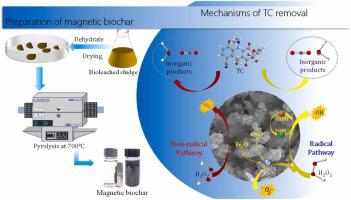当前位置:
X-MOL 学术
›
Process Saf. Environ. Prot.
›
论文详情
Our official English website, www.x-mol.net, welcomes your feedback! (Note: you will need to create a separate account there.)
Preparation of magnetic biochar used bioleached sludge to enhance tetracycline removal in a heterogeneous Fenton-like system
Process Safety and Environmental Protection ( IF 6.9 ) Pub Date : 2024-06-21 , DOI: 10.1016/j.psep.2024.06.072 Yunbei Li , Hailong Li , Yu Zhang , Jiaxin Zhang , Shipeng Wang , Jinghua Lv
Process Safety and Environmental Protection ( IF 6.9 ) Pub Date : 2024-06-21 , DOI: 10.1016/j.psep.2024.06.072 Yunbei Li , Hailong Li , Yu Zhang , Jiaxin Zhang , Shipeng Wang , Jinghua Lv

|
The environmental application of iron (Fe)-rich acidic sludge generated after bioleaching is still a challenge. Pyrolysis offers a promising avenue for converting this sludge into biochar. In this study, magnetic biochar (BLS-BC7) was prepared from acidic Fe-rich sludge and employed as a catalyst for tetracycline (TC) degradation by hydrogen peroxide (HO). Furthermore, compared with the original sludge-based biochar, BLS-BC exhibited a 2.3 times higher specific surface area, providing more active sites for the catalytic reactions. The scanning electron microscopy and Raman results indicated that BLS-BC7 was coated with a large number of particles on its surface, presenting a rough appearance with a high degree of defects, thereby providing more active sites for biochar. Characterization via photoelectron spectroscopy, elemental analysis, and Fourier transform infrared spectroscopy results indicated that BLS-BC contained a higher amount of oxygen functional groups, along with an increased content of CO and the formation of Fe–O, facilitating HO activation to generate reactive oxygen species (ROS). Additionally, quenching experiments and electron paramagnetic resonance spectroscopy demonstrated the generation of multiple ROS such as O, ·OH, and , in the BLS-BC7/HO system. This resulted in a TC removal rate of 100 % within 120 min, with a mineralization rate of 53.4 %. The biochar exhibited easy recoverability and strong reusability, maintaining a TC removal rate of 91.3 % after five cycles of experiments. The X-ray diffraction patterns before and after the reaction showed that BLS-BC7 exhibited strong stability, with no apparent change in peak positions before and after use.
中文翻译:

使用生物浸出污泥制备磁性生物炭以增强非均质类芬顿系统中四环素的去除
生物浸出后产生的富铁酸性污泥的环境应用仍然是一个挑战。热解为将这种污泥转化为生物炭提供了一条有前途的途径。在这项研究中,磁性生物炭(BLS-BC7)是由酸性富铁污泥制备而成,并用作过氧化氢(H2O)降解四环素(TC)的催化剂。此外,与原始污泥生物炭相比,BLS-BC的比表面积提高了2.3倍,为催化反应提供了更多的活性位点。扫描电镜和拉曼结果表明,BLS-BC7表面包覆有大量颗粒,呈现出粗糙的外观,缺陷程度较高,从而为生物炭提供了更多的活性位点。通过光电子能谱、元素分析和傅里叶变换红外光谱的表征结果表明,BLS-BC 含有更多的氧官能团,同时 CO 含量增加并形成 Fe-O,有利于 H2O 活化产生活性氧物种(ROS)。此外,猝灭实验和电子顺磁共振波谱证明了 BLS-BC7/H2O 系统中产生了多种 ROS,例如 O、·OH 和 。 120 分钟内 TC 去除率为 100%,矿化率为 53.4%。该生物炭具有易回收性和较强的可重复使用性,经过五个循环实验后,TC去除率仍保持在91.3%。反应前后的X射线衍射图表明BLS-BC7表现出很强的稳定性,使用前后峰位置没有明显变化。
更新日期:2024-06-21
中文翻译:

使用生物浸出污泥制备磁性生物炭以增强非均质类芬顿系统中四环素的去除
生物浸出后产生的富铁酸性污泥的环境应用仍然是一个挑战。热解为将这种污泥转化为生物炭提供了一条有前途的途径。在这项研究中,磁性生物炭(BLS-BC7)是由酸性富铁污泥制备而成,并用作过氧化氢(H2O)降解四环素(TC)的催化剂。此外,与原始污泥生物炭相比,BLS-BC的比表面积提高了2.3倍,为催化反应提供了更多的活性位点。扫描电镜和拉曼结果表明,BLS-BC7表面包覆有大量颗粒,呈现出粗糙的外观,缺陷程度较高,从而为生物炭提供了更多的活性位点。通过光电子能谱、元素分析和傅里叶变换红外光谱的表征结果表明,BLS-BC 含有更多的氧官能团,同时 CO 含量增加并形成 Fe-O,有利于 H2O 活化产生活性氧物种(ROS)。此外,猝灭实验和电子顺磁共振波谱证明了 BLS-BC7/H2O 系统中产生了多种 ROS,例如 O、·OH 和 。 120 分钟内 TC 去除率为 100%,矿化率为 53.4%。该生物炭具有易回收性和较强的可重复使用性,经过五个循环实验后,TC去除率仍保持在91.3%。反应前后的X射线衍射图表明BLS-BC7表现出很强的稳定性,使用前后峰位置没有明显变化。











































 京公网安备 11010802027423号
京公网安备 11010802027423号